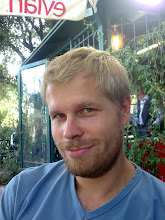After our great stay in the Izu Peninsula, it felt almost wistful to return to Tokyo. We made it to Kitasenju, where we met our good friend Matsuoka-san, who set us up in what would be our home for the next couple of weeks. Our apartment is truly super-modern (there's an intercom with camera, a bathtub that can be heated and filled remotely from the kitchen, some motion-controlled lighting, to mention but a few of the features available...).
There wasn't much in the way of furniture, but we were able to purchase some second-hand appliances (a washing machine, fridge and micro-wave oven) for the ridiculous price of 80 Euros! Now that's what I call a bargain! The rest we were able to find thanks to our good friend Matsuoka, and those wonderful 100 Yen shops you can find all over Tokyo (basically, they sell all sorts of useful items for the ridiculous price of 100 Yen each, which is basically less than 1 Euro!).
So, we ended up with a furnished flat in just a couple of days of intensive shopping. We also had a little bit of time to explore Kitasenju before our Japanese courses were starting. It's a really great place to live, honestly. Kitasenju is great for several reasons: it feels like a real neighborhood, it's very lively with plenty of bars and restaurants, plus it's cheaper than central Tokyo, since it's not touristy.
And it's a real transportation hub too, with good underground and train connections. It's got a similar feel to the more famous Asakusa, which is quite a touristy part of Tokyo, which evokes a bit of the old-Tokyo atmosphere (as compared to the skyscraper-dominated more modern parts of Tokyo like Shinjuku, Roppongi or Shibuya). We experimented quite a few of those bars and restaurants with our guide Matsuoka-san during the first few days.
Monday, it was time to start our intensive Japanese course at Iidabashi, at Coto language academy. We paid rather a lot of money for those courses, so expectations were high. And they were certainly met. We had 3 hours of courses per day, which is just about perfect (long enough to really learn new things every day, but short enough to no exceed our attention span), and the teachers are great, too. All Japanese, of course. We shall see how much Japanese we'll have learnt at the end of it all!
We're very well located for doing a bit of sports, too. The flat is just 100 meters from the Akagawa river, and there's a great pedestrian road just by the river, just perfect for running and cycling. The plan is to run at least 3 or 4 times a week. Japan is still pretty suffocating and hot, so the only time it's really practical to run is early in the morning (and it's already pretty hot at 8 o'clock). On our first run; on Sunday, there were loads of kids playing baseball by the riverside, which was pretty cool to see. There's a public swimming pool as well, which we are meaning to check out soon.
There wasn't much in the way of furniture, but we were able to purchase some second-hand appliances (a washing machine, fridge and micro-wave oven) for the ridiculous price of 80 Euros! Now that's what I call a bargain! The rest we were able to find thanks to our good friend Matsuoka, and those wonderful 100 Yen shops you can find all over Tokyo (basically, they sell all sorts of useful items for the ridiculous price of 100 Yen each, which is basically less than 1 Euro!).
So, we ended up with a furnished flat in just a couple of days of intensive shopping. We also had a little bit of time to explore Kitasenju before our Japanese courses were starting. It's a really great place to live, honestly. Kitasenju is great for several reasons: it feels like a real neighborhood, it's very lively with plenty of bars and restaurants, plus it's cheaper than central Tokyo, since it's not touristy.
And it's a real transportation hub too, with good underground and train connections. It's got a similar feel to the more famous Asakusa, which is quite a touristy part of Tokyo, which evokes a bit of the old-Tokyo atmosphere (as compared to the skyscraper-dominated more modern parts of Tokyo like Shinjuku, Roppongi or Shibuya). We experimented quite a few of those bars and restaurants with our guide Matsuoka-san during the first few days.
Monday, it was time to start our intensive Japanese course at Iidabashi, at Coto language academy. We paid rather a lot of money for those courses, so expectations were high. And they were certainly met. We had 3 hours of courses per day, which is just about perfect (long enough to really learn new things every day, but short enough to no exceed our attention span), and the teachers are great, too. All Japanese, of course. We shall see how much Japanese we'll have learnt at the end of it all!
We're very well located for doing a bit of sports, too. The flat is just 100 meters from the Akagawa river, and there's a great pedestrian road just by the river, just perfect for running and cycling. The plan is to run at least 3 or 4 times a week. Japan is still pretty suffocating and hot, so the only time it's really practical to run is early in the morning (and it's already pretty hot at 8 o'clock). On our first run; on Sunday, there were loads of kids playing baseball by the riverside, which was pretty cool to see. There's a public swimming pool as well, which we are meaning to check out soon.



























































